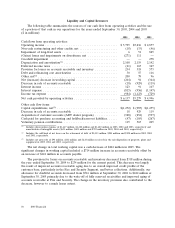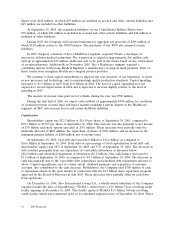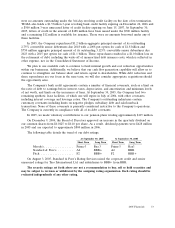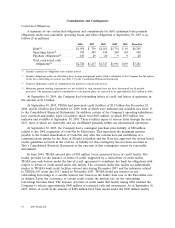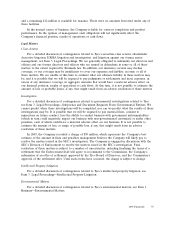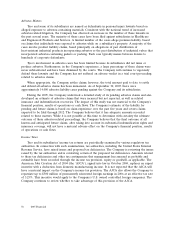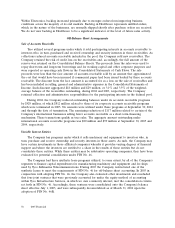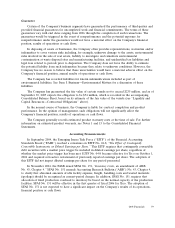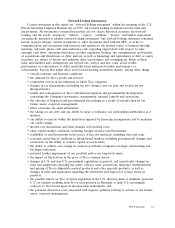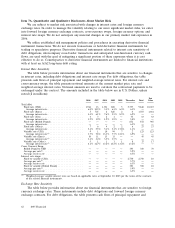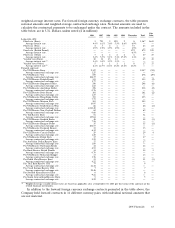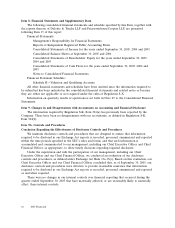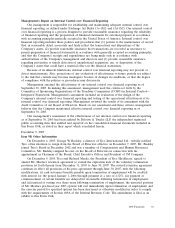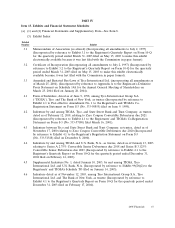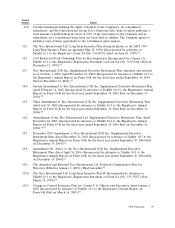ADT 2005 Annual Report Download - page 136
Download and view the complete annual report
Please find page 136 of the 2005 ADT annual report below. You can navigate through the pages in the report by either clicking on the pages listed below, or by using the keyword search tool below to find specific information within the annual report.In December 2004, the FASB issued SFAS No. 123R which requires all share-based payments to
employees to be recognized in the financial statements based on their fair values. SFAS No. 123R
replaces SFAS No. 123, ‘‘Accounting for Stock-Based Compensation,’’ and supersedes Accounting
Principles Board Opinion No. 25 (‘‘APB Opinion No. 25’’), ‘‘Accounting for Stock Issued to Employees.’’
Effective October 1, 2005, Tyco adopted the provisions of SFAS No. 123R using the modified
prospective method. Under this method compensation expense is recorded for all unvested options over
the related vesting period beginning in the quarter of adoption. The Company previously applied the
intrinsic value based method prescribed in APB Opinion No. 25 in accounting for employee stock-
based compensation. Upon adoption of SFAS No. 123R, the Company will recognize stock-based
compensation costs ratably over the service period, which is the earlier of the retirement eligibility date,
if the grant contains provisions such that the award becomes fully vested upon retirement, or the stated
vesting period. For grants issued to retirement eligible employees prior to the adoption of SFAS
No. 123R, the Company will recognize compensation costs over the stated vesting period with
acceleration of any unrecognized compensation costs if and when an employee elects to retire. This
statement also amends SFAS No. 95, ‘‘Statement of Cash Flows,’’ to require that excess tax benefits be
reflected as financing cash inflows rather than operating cash inflows. The impact of the adoption of
SFAS No. 123R is estimated to result in a compensation charge for fiscal year 2006 in the range of
approximately $0.06 to $0.07 per diluted share.
In March 2005, the SEC issued Staff Accounting Bulletin (‘‘SAB’’) No. 107 regarding the Staff’s
interpretation of SFAS No. 123R. This interpretation provides the Staff’s views regarding interactions
between SFAS No. 123R and certain SEC rules and regulations and provides interpretations of the
valuation of share-based payments for public companies. The interpretive guidance is intended to assist
companies in applying the provisions of SFAS No. 123R and investors and users of the financial
statements in analyzing the information provided. The Company will follow the guidance prescribed in
SAB No. 107 in connection with its adoption of SFAS No. 123R.
In March 2005, the FASB issued Interpretation (‘‘FIN’’) No. 47, ‘‘Accounting for Conditional Asset
Retirement Obligations—an interpretation of FASB Statement No. 143.’’ This Interpretation clarifies the
timing of liability recognition for legal obligations associated with an asset retirement when the timing
and (or) method of settling the obligation are conditional on a future event that may or may not be
within the control of the entity. FIN No. 47 is effective no later than the end of fiscal years ending
after December 15, 2005. The Company is currently assessing the impact that FIN No. 47 will have on
the results of its operations, financial position or cash flows.
In June 2005, the FASB issued Staff Position (‘‘FSP’’) No. 143-1, ‘‘Accounting for Electronic
Equipment Waste Obligations,’’ which provides guidance on accounting for historical waste obligations
associated with the European Union Waste, Electrical and Electronic Equipment Directive (‘‘WEEE
Directive’’). FSP No. 143-1 is effective for the first reporting period ending after June 8, 2005 or the
date of the adoption of the WEEE Directive into law by the applicable European Union member
country. Because European Union member countries have not yet, among other steps, (i) fully enacted
their national laws relating to WEEE, (ii) completed implementation of their administrative measures
and programs, (iii) clarified the scope of products considered WEEE, and/or (iv) established pricing for
recycling of WEEE, the Company can not at this time reasonably estimate the effect of applying this
guidance in future periods. The Company continues to monitor WEEE developments in the respective
EU countries in an effort to reflect the impact of this Directive.
60 2005 Financials


